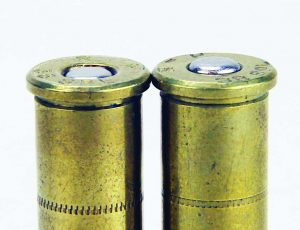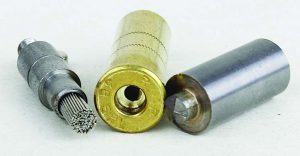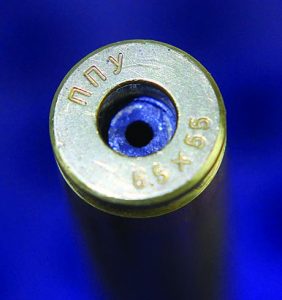By Art Merrill | Contributing Editor

A high primer (R) can cause misfires and other problems, as well.
Handloading is rarely a hit-or-miss affair. Instead, the practice—to be successful at it, anyway—is one of careful methodology. We have a staggering quantity of carefully compiled load data we can access, and the handloading process itself has been thoroughly worked out by our predecessors. However, we deal with a great many variables in firearms and ammunition components, all and any of which can impact results, sometimes significantly. So, we need a method to avoid madness.
Our loading technique also impacts our results, perhaps even more so than does substituting components. In teaching handloading to others, I’ve only seen one neophyte who just couldn’t seem to get the knack of it quickly enough to keep his interest, and he gave up the pursuit. And once or twice each year I find in my buddy’s gun shop a complete handloading setup that someone has consigned or sold for whatever reason.
I suspect the reason, much of the time, is a loss of interest due to frustration at a lack of success that can be directly attributed to poor loading techniques. Poor technique can also mislead a handloader into suspecting a problem may lie with a component or tool or firearm, rather than with himself. I discovered this yet again last year when a gunsmith friend turned a problem over to me.
A customer believed his problem with misfires in an older .38 Special Smith & Wesson revolver lay with the revolver itself. The misfires persisted after my friend examined and tested the revolver; the customer argued that his handloads were perfectly fine and insisted the revolver was still at fault. Long story considerably truncated, I accepted the revolver and handloads for evaluation to determine the reason for the misfires.
I share that (admittedly somewhat dry) evaluation with you here so that you might see the value in a careful methodology when troubleshooting similar problems. What follows is a copy of the report I submitted to the gunsmith for the customer.
The evaluation
Revolver experiences occasional misfires with attendant light primer strikes. Also reported, a second hammer blow to these misfires will fire the cartridges.
The revolver appears in excellent mechanical condition, with normal cylinder end play. The hammer nose appears normal. A subjective evaluation of the hammer fall in both double action and single action also appears normal. It appears the revolver has had a trigger job; mainspring strength (again a subjective evaluation) appears normal.
Customer provided three samples of handloaded ammunition to evaluate in the revolver, which I separated into three groups; a box of Federal factory loaded ammo served as the control group.
Blue box of 50 rounds: Group 1.
Red box of several hundred loose rounds: Group 2.
Purple box of several hundred loose rounds: Group 3.
First Step
Examining primers resulted in the following:
- Group 1. Of the 50 rounds, nine (9) had high primers—that is, protruding primers not seated flush with or below the cartridge case head. This represents 18% of the group exhibiting high primers.
- Group 2. Of 50 rounds checked, six (6) had high primers. That’s 12% with high primers.
- Group 3. Of 25 rounds checked, 23 had high primers. With that great a percentage of high primers I felt there was no need to check another 25. That’s 94% with high primers.
Among Group 2 I noted two primers that had flattened slightly or that exhibited small flat spots indicating more than usual force used to seat the primers.
I fired a sampling of 30 rounds from each group, including all the rounds with the known high primers in Groups 1 and 2, plus 30 rounds from the control group. I felt this amount is enough to determine whether the problem likely rests with the revolver or the ammunition. I fired the revolver double action, as in this mode the hammer falls a shorter distance and therefore with less force than in single action, and would theoretically more likely result in a misfire.
Shooting results

A primer pocket cleaning tool (L) will remove firing residue; a primer pocket uniforming tool (R) will deepen the pocket and help prevent high primers.
Control group: No misfires.
Group 1. One misfire. About a 4% failure rate. Note this misfire was not among the cartridges in this group with a high primer. Primer strike appears to be light.
Group 2. No misfires.
Group 3. Three misfires. 10% failure rate. All three misfires have high primers. Primer strike appears to be lighter than that on fired cartridges.
Conclusion
Group 3, with the largest percentage of high primers, also had the highest failure rate. Group 1, with the next highest incidence of high primers, had the next highest failure rate. Group 2, with the lowest incidence of high primers, had no failures. The control group, with no high primers, had no failures.
Analysis shows that, the larger the percentage of high primers in a group, the greater the failure rate of that group. Also, there were no misfires with factory ammunition. These conclusions indicate the problem likely lies with the handloaded ammunition, not the revolver.
Causative factors
The indicated causative factor is the high primers, which may move slightly forward under a hammer blow without igniting and leaving a light primer strike. However, this does not preclude the possibility of a random distribution of faulty primers throughout the samples. The latter is perhaps supported by the one failure in Group 1, which was not one of the nine cartridges that had a high primer. Though all primers are CCI 500, according to the data provided by the customer, each group has primers of a differing lot number; this may or may not have any bearing on the relative quality of all the primers.
(Another possible causative factor is that the customer might have unintentionally utilized small rifle primers, which are known to cause exactly this problem of misfires.)
Contributing factors
A possible contributing factor is reloading technique—specifically, not stroking the press handle with enough force to seat primers deeply and uniformly. The high primers that constitute 94% of the cartridges examined in Group 3, attended by Group 3’s comparatively high failure rate, strongly supports this possibility.
A second possibility may be attributed to the customer reloading on a progressive press. On a progressive press primer pockets are typically not cleaned before seating new primers; a dirty primer pocket can prevent a fresh primer from seating completely to the bottom of the primer pocket. However, in my experience the high percentage of high primers in Group 3 is far more than I would attribute simply to dirty primer pockets.
There might be a needed adjustment or a mechanical problem with the press’s shell plate or primer seater. Further speculations about the press would require examination.
Recommendations

Residue from a previously fired primer can prevent a new primer from seating fully.
Seat primers flush with or below the level of the case head. Test this by standing the primed cartridge on its case head on a flat surface and looking for the case to “wobble.” To accomplish:
- Apply enough force to the press handle to fully seat primers.
- Clean primer pockets before reloading.
- Cut primer pockets to a uniform depth with a tool made for that purpose. This may preclude the need for cleaning pockets before reloading on a progressive press, and it will ease primer seating.
Especially in an older revolver, or if the revolver has had a trigger job that included lightening the hammer mainspring, it’s possible that the force of the hammer fall is not enough to reliably ignite the CCI primers even when properly seated.
- Try Federal primers. According to Lee Precision research, Federal primers are somewhat more sensitive than other brands, including CCI. Note there were no misfires using the Federal control group ammunition in testing here.
Logic
Of course, we don’t speak in exactly these terms when we talk about troubleshooting a problem, and one could condense the above report into, “If you’re absolutely sure you didn’t use rifle primers, the problem is high primers; check your loading technique.” While my original point was to reinforce my conclusions by detailing my steps for an insistent customer, here it serves to illustrate a logical methodology for troubleshooting a problem with misfiring handloads.
There’s a lot of physics and math at work in handloading; it makes sense then to approach problems methodically, rather than hit-or-miss.



